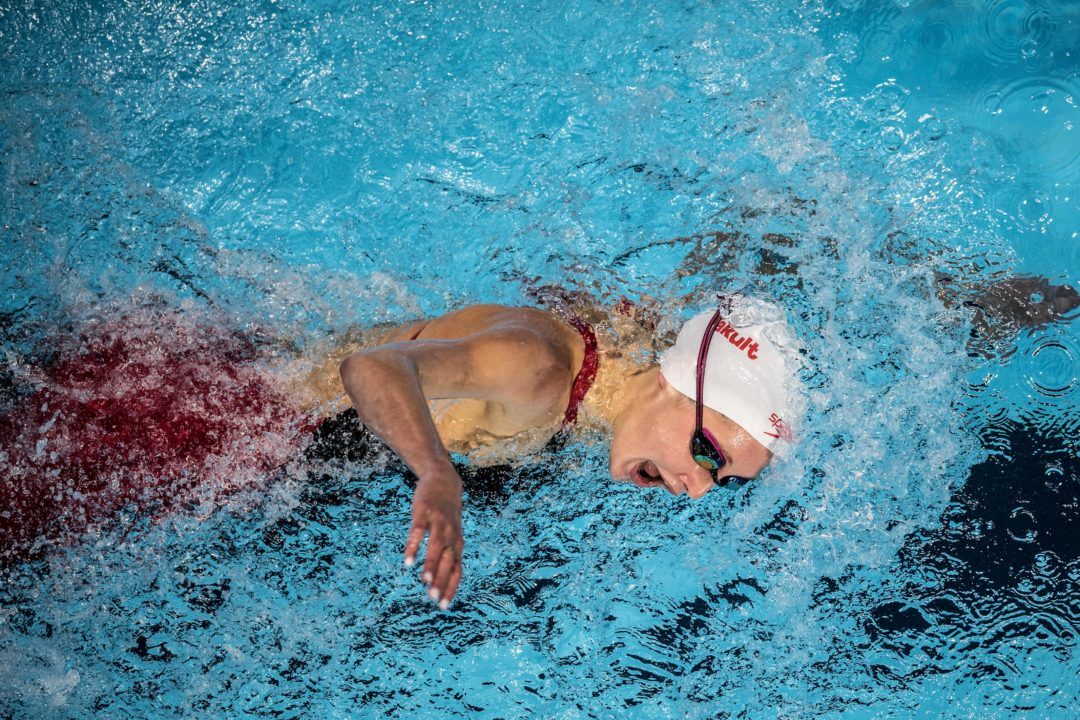Courtesy of Gary Hall Sr., 10-time World Record Holder, 3-time Olympian, 1976 Olympic Games US Flagbearer and The Race Club co-founder.
Of the thousands of swimmers who have come to The Race Club, we have found that a very high percentage of them are being taught to breathe to both sides in freestyle, often referred to as bilateral breathing. Observing elite freestylers of both genders, one finds very few of them ever breathe to both sides. That begs the question: Should we be teaching young swimmers to breathe to both sides, and if so, why?
I have heard various coaches explain that they do so for balance, but what does that mean? Balance of what? In water, a swimmer weighs very little, almost zero, so achieving balance in the traditional way of thinking about balance on land does not apply. Swimmers are suspended by their buoyancy and the density of the water and aren’t going to fall anywhere.
There does need to be some balance in propulsion since the hands and feet that are generating propulsion are doing so on one side or the other side of the midline of the swimmer’s body. If all of the propulsion were coming from just one side, the swimmer would tend to veer off to the other side. Breathing to both sides shouldn’t significantly affect a swimmer’s propulsion, so that explanation doesn’t work.
I have also heard coaches speak of developing muscular balance by advocating bilateral breathing techniques. Is that true? Do swimmers pull harder or kick harder on the breath side than on the non-breath side? If so, we would likely see the strength of an elite swimmer’s arms greater on one side than the other, since nearly all breath to one side only. We don’t.
What about shoulder injury? Does breathing to one side result in more torque or stress on a swimmer’s shoulder and lead to a greater chance of injury? If so, I have not seen the data to support that. Shoulder problems are common in all swimmers but often occur in both shoulders, not just one. Even if the shoulder issue is on one side, is it because of breathing to one side or poor pulling mechanics? Or something else?
What about race strategy? Do we want our swimmers to breathe to both sides to catch a view of the field of swimmers on either side of them? I doubt it. Most coaches prefer that their swimmers pay more attention to what they are doing during the race, rather than trying to catch a glimpse of others in the race. I can understand how having the skill to breathe to both sides during an open water race is important, as conditions may dictate that a swimmer breathes to one side or the other. But not in the pool.
Finally, I want to point out that by training our swimmers to breathe bilaterally, which is a 1:3 pattern, one breath per three strokes, we are training swimmers hypoxically. In events longer than 200 meters, the majority of the body’s energy is provided by the aerobic system. For athletic events on land of that duration of 2 minutes or longer, the typical respiratory rate is 50-60 breaths per minute – nearly a breath is taken every second. That seems to be the ideal rate. Breathing faster than that results in inefficient air exchange, and breathing slower than that simply does not provide adequate amounts of oxygen nor rid the body of enough CO2.
If a swimmer is racing at the stroke rate of 90 per minute, which is often achieved, breathing every third stroke results in a respiratory rate of 30 breaths per minute, far below the normal physiological breathing rate. As a result, a swimmer breathing bilaterally will eventually slow down, if the race is long enough so that their energy demand is lessened to meet the slower delivery of oxygen.
When teaching swimmers to breathe in freestyle at The Race Club, we often find that they swim better and faster by breathing to one side than the other. That could be as a result of better pulling mechanics (greater propulsion) or causing less drag or both. Our job is to figure out on which side of the swimmer is the breath better taken. Then we try to teach them to take a low-profile breath, keeping the crowns of their heads pointing forward during the breath, causing the least amount of increased frontal drag. Finally, for races of 200 meters or longer, we encourage swimmers to breathe every cycle or even more for longer events, by taking consecutive breaths going into and out of turns. For these longer events, swimmers need to keep the pipeline of oxygen coming in. Breathe, baby, breathe.
Yours in swimming,
Gary Sr.
Like The Race Club on Facebook
Follow The Race Club on Instagram
Follow The Race Club on Twitter
Connect to The Race Club / Gary Hall Sr. on Linkedin
THE RACE CLUB
Because Life is Worth Swimming, our mission is to promote swimming through sport, lifelong enjoyment, and good health benefits. Our objective is for each member of and each participant in The Race Club to improve his or her swimming performances, health, and self-esteem through our educational programs, services and creativity. We strive to help each member of The Race Club overcome challenges and reach his or her individual life goals.
The Race Club provides facilities, coaching, training, technical instruction, video, fitness and health programs for swimmers of all ages and abilities. Race Club swim camps are designed and tailored to satisfy each swimmer’s needs, whether one is trying to reach the Olympic Games or simply improve one’s fitness. Our programs are suitable for beginner swimmers, pleasure swimmers, fitness swimmers, USA swimming or YMCA swimmers, or triathletes; anyone who wants to improve swimming skills. All of our Race Club members share an enjoyment of being in the water and use swimming to stimulate a more active mind and body.


